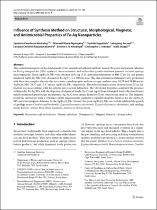| dc.contributor.author | Noukelag, Sandrine Kamdoum | |
| dc.contributor.author | Ngqoloda, Siphelo | |
| dc.contributor.author | Mewa‑Ngongang, Maxwell | |
| dc.contributor.author | Kotsedi, Lebogang | |
| dc.contributor.author | Razanamahandry, Lovasoa Christine | |
| dc.contributor.author | Ntwamp, Seteno | |
| dc.contributor.author | Arendse, Christopher | |
| dc.contributor.author | Maaza, Malik | |
| dc.date.accessioned | 2024-01-29T11:06:14Z | |
| dc.date.available | 2024-01-29T11:06:14Z | |
| dc.date.issued | 2023 | |
| dc.identifier.citation | Noukelag, S.K., Mewa-Ngongang, M., Ngqoloda, S., Kotsedi, L., Razanamahandry, L.C., Ntwampe, S.K., Arendse, C.J. and Maaza, M., 2023. Influence of synthesis method on structural, morphological, magnetic, and antimicrobial properties of Fe-Ag nanoparticles. Journal of Inorganic and Organometallic Polymers and Materials, 33(1), pp.159-169. | en_US |
| dc.identifier.issn | 15741443 | |
| dc.identifier.uri | http://dx.doi.org/10.1007/s10904-022-02493-9 | |
| dc.identifier.uri | http://hdl.handle.net/10566/9280 | |
| dc.description.abstract | This contribution reports on the development of two versatile and efcient methods, namely the green and gamma radiolysis for Fe-Ag nanoparticles (NPs) synthesis, characterization, and further their growth inhibition potential on some spoilage microorganisms. Green Ag/Fe2O3 NPs were obtained at Fe-Ag [3:1], annealing temperature of 800 °C for 2 h, and gamma irradiated Ag/Fe3O4 NPs were obtained at Fe-Ag [7:1], a 50 kGy dose. The characterization techniques were performed with these two samples whereby the sizes from crystallographic and microscopic analyses were 39.59 and 20.00 nm for Ag/Fe2O3 NPs, 28.57 and 15.37 nm for Ag/Fe3O4 NPs, respectively. The polycrystallinity nature observed from X-ray diffraction was in accordance with the selected area electron difraction. The vibrational properties confrmed the presence of bimetallic Fe-Ag NPs with the depiction of chemical bonds, Fe–O and Ag–O from attenuated total refection-Fourier transform infrared spectroscopy and elements Ag, Fe, O from energy-dispersive X-ray spectroscopy analyses. The magnetic properties carried out using a vibrating sample magnetometer suggested a superparamagnetic behavior for the Ag/Fe2O3 NPs and a ferromagnetic behavior for the Ag/Fe3O4 NPs. Overall, the green Ag/Fe2O3 NPs successfully inhibited the growth of spoilage yeasts Candida guilliermondii, Zygosaccharomyces fermentati, Zygosaccharomyces forentinus, and spoilage molds Botrytis cinerea, Penicillium expansum, Alternaria alstroemeriae. | en_US |
| dc.language.iso | en | en_US |
| dc.publisher | Springer | en_US |
| dc.subject | Nanoparticles | en_US |
| dc.subject | Magnetic behavior | en_US |
| dc.subject | Antimicrobial | en_US |
| dc.subject | Gamma radiolysis | en_US |
| dc.title | Infuence of Synthesis Method on Structural, Morphological, Magnetic, and Antimicrobial Properties of Fe‑Ag Nanoparticles | en_US |
| dc.type | Article | en_US |

